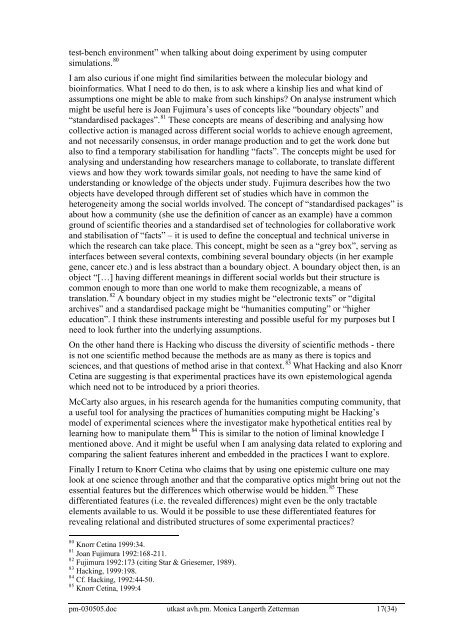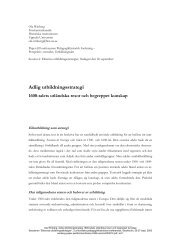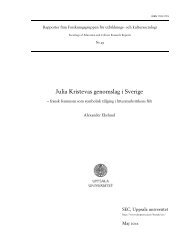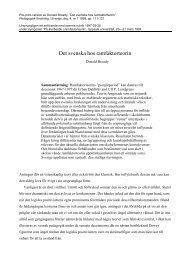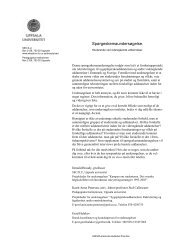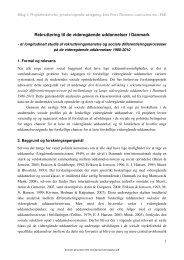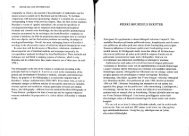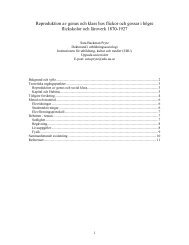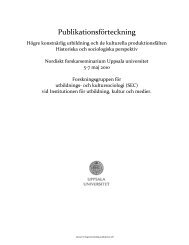exploring uses of digital archives in research and ... - skeptron.uu.se
exploring uses of digital archives in research and ... - skeptron.uu.se
exploring uses of digital archives in research and ... - skeptron.uu.se
You also want an ePaper? Increase the reach of your titles
YUMPU automatically turns print PDFs into web optimized ePapers that Google loves.
test-bench environment” when talk<strong>in</strong>g about do<strong>in</strong>g experiment by us<strong>in</strong>g computersimulations. 80I am also curious if one might f<strong>in</strong>d similarities between the molecular biology <strong>and</strong>bio<strong>in</strong>formatics. What I need to do then, is to ask where a k<strong>in</strong>ship lies <strong>and</strong> what k<strong>in</strong>d <strong>of</strong>assumptions one might be able to make from such k<strong>in</strong>ships? On analy<strong>se</strong> <strong>in</strong>strument whichmight be u<strong>se</strong>ful here is Joan Fujimura’s <strong>u<strong>se</strong>s</strong> <strong>of</strong> concepts like “boundary objects” <strong>and</strong>“st<strong>and</strong>ardi<strong>se</strong>d packages”. 81 The<strong>se</strong> concepts are means <strong>of</strong> describ<strong>in</strong>g <strong>and</strong> analys<strong>in</strong>g howcollective action is managed across different social worlds to achieve enough agreement,<strong>and</strong> not necessarily con<strong>se</strong>nsus, <strong>in</strong> order manage production <strong>and</strong> to get the work done butalso to f<strong>in</strong>d a temporary stabilisation for h<strong>and</strong>l<strong>in</strong>g “facts”. The concepts might be u<strong>se</strong>d foranalys<strong>in</strong>g <strong>and</strong> underst<strong>and</strong><strong>in</strong>g how <strong>re<strong>se</strong>arch</strong>ers manage to collaborate, to translate differentviews <strong>and</strong> how they work towards similar goals, not need<strong>in</strong>g to have the same k<strong>in</strong>d <strong>of</strong>underst<strong>and</strong><strong>in</strong>g or knowledge <strong>of</strong> the objects under study. Fujimura describes how the twoobjects have developed through different <strong>se</strong>t <strong>of</strong> studies which have <strong>in</strong> common theheterogeneity among the social worlds <strong>in</strong>volved. The concept <strong>of</strong> “st<strong>and</strong>ardi<strong>se</strong>d packages” isabout how a community (she u<strong>se</strong> the def<strong>in</strong>ition <strong>of</strong> cancer as an example) have a commonground <strong>of</strong> scientific theories <strong>and</strong> a st<strong>and</strong>ardi<strong>se</strong>d <strong>se</strong>t <strong>of</strong> technologies for collaborative work<strong>and</strong> stabilisation <strong>of</strong> “facts” – it is u<strong>se</strong>d to def<strong>in</strong>e the conceptual <strong>and</strong> technical univer<strong>se</strong> <strong>in</strong>which the <strong>re<strong>se</strong>arch</strong> can take place. This concept, might be <strong>se</strong>en as a “grey box”, <strong>se</strong>rv<strong>in</strong>g as<strong>in</strong>terfaces between <strong>se</strong>veral contexts, comb<strong>in</strong><strong>in</strong>g <strong>se</strong>veral boundary objects (<strong>in</strong> her examplegene, cancer etc.) <strong>and</strong> is less abstract than a boundary object. A boundary object then, is anobject “[…] hav<strong>in</strong>g different mean<strong>in</strong>gs <strong>in</strong> different social worlds but their structure iscommon enough to more than one world to make them recognizable, a means <strong>of</strong>translation. 82 A boundary object <strong>in</strong> my studies might be “electronic texts” or “<strong>digital</strong><strong>archives</strong>” <strong>and</strong> a st<strong>and</strong>ardi<strong>se</strong>d package might be “humanities comput<strong>in</strong>g” or “highereducation”. I th<strong>in</strong>k the<strong>se</strong> <strong>in</strong>struments <strong>in</strong>terest<strong>in</strong>g <strong>and</strong> possible u<strong>se</strong>ful for my purpo<strong>se</strong>s but Ineed to look further <strong>in</strong>to the underly<strong>in</strong>g assumptions.On the other h<strong>and</strong> there is Hack<strong>in</strong>g who discuss the diversity <strong>of</strong> scientific methods - thereis not one scientific method becau<strong>se</strong> the methods are as many as there is topics <strong>and</strong>sciences, <strong>and</strong> that questions <strong>of</strong> method ari<strong>se</strong> <strong>in</strong> that context. 83 What Hack<strong>in</strong>g <strong>and</strong> also KnorrCet<strong>in</strong>a are suggest<strong>in</strong>g is that experimental practices have its own epistemological agendawhich need not to be <strong>in</strong>troduced by a priori theories.McCarty also argues, <strong>in</strong> his <strong>re<strong>se</strong>arch</strong> agenda for the humanities comput<strong>in</strong>g community, thata u<strong>se</strong>ful tool for analys<strong>in</strong>g the practices <strong>of</strong> humanities comput<strong>in</strong>g might be Hack<strong>in</strong>g’smodel <strong>of</strong> experimental sciences where the <strong>in</strong>vestigator make hypothetical entities real bylearn<strong>in</strong>g how to manipulate them. 84 This is similar to the notion <strong>of</strong> lim<strong>in</strong>al knowledge Imentioned above. And it might be u<strong>se</strong>ful when I am analys<strong>in</strong>g data related to <strong>explor<strong>in</strong>g</strong> <strong>and</strong>compar<strong>in</strong>g the salient features <strong>in</strong>herent <strong>and</strong> embedded <strong>in</strong> the practices I want to explore.F<strong>in</strong>ally I return to Knorr Cet<strong>in</strong>a who claims that by us<strong>in</strong>g one epistemic culture one maylook at one science through another <strong>and</strong> that the comparative optics might br<strong>in</strong>g out not thees<strong>se</strong>ntial features but the differences which otherwi<strong>se</strong> would be hidden. 85 The<strong>se</strong>differentiated features (i.e. the revealed differences) might even be the only tractableelements available to us. Would it be possible to u<strong>se</strong> the<strong>se</strong> differentiated features forreveal<strong>in</strong>g relational <strong>and</strong> distributed structures <strong>of</strong> some experimental practices?80 Knorr Cet<strong>in</strong>a 1999:34.81 Joan Fujimura 1992:168-211.82 Fujimura 1992:173 (cit<strong>in</strong>g Star & Grie<strong>se</strong>mer, 1989).83 Hack<strong>in</strong>g, 1999:198.84 Cf. Hack<strong>in</strong>g, 1992:44-50.85 Knorr Cet<strong>in</strong>a, 1999:4pm-030505.doc utkast avh.pm. Monica Langerth Zetterman 17(34)


